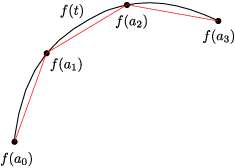Let ![]() be a curve in
be a curve in ![]() . How would you find the length of the curve? One
approach is to start by approximating the curve with segments.
. How would you find the length of the curve? One
approach is to start by approximating the curve with segments.
Divide the base interval ![]() up into subintervals:
up into subintervals:
![]()
This is called a partition of the subinterval. You may recall doing this to set up Riemann sums.
If you plug the a's into f, you get points on the curve which you can connect with segments. Here's a pictures with 4 points and 3 segments:

The sum of the segments lengths approximates the length of the curve.
Definition. A curve ![]() is rectifiable if
the sums of the segment lengths have an upper
bound: that is, there is a number M such that for every
partitition of
is rectifiable if
the sums of the segment lengths have an upper
bound: that is, there is a number M such that for every
partitition of ![]() , the sum of the segment lengths
is less than M.
, the sum of the segment lengths
is less than M.
If a curve is rectifiable, the length of the curve is least upper bound of the numbers M which bound the sums of segment lengths for all partititions.
If a curve has reasonable properties, we can compute the length using an integral.
Theorem. Suppose ![]() is a curve where f is differentiable and
is a curve where f is differentiable and
![]() is continuous. Then f is rectifiable, and the length
of f is
is continuous. Then f is rectifiable, and the length
of f is
![]()
While the proof is a little technical, we can see why this makes
sense. ![]() is the speed of an
object moving along the curve. In a small increment
is the speed of an
object moving along the curve. In a small increment ![]() of time, the object moves a distance
of time, the object moves a distance ![]() . If we let the time increments go to 0 and
add up the distances by integrating, we get the distance travelled by
the object, which is the length of the curve.
. If we let the time increments go to 0 and
add up the distances by integrating, we get the distance travelled by
the object, which is the length of the curve.
Example. Find the length of the curve
![]()
![]()
![]()
![]()
![]()
The length is
![]()
Example. Find the length of the curve
![]()
![]()
![]()
![]()
![]()
The length is
![]()
Copyright 2018 by Bruce Ikenaga